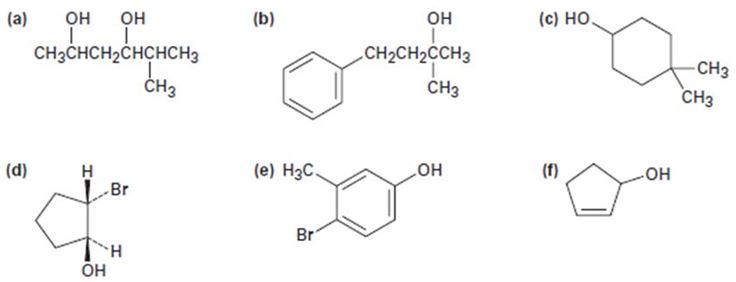
Organic Chemistry
9th Edition
ISBN: 9781305080485
Author: John E. McMurry
Publisher: Cengage Learning
expand_more
expand_more
format_list_bulleted
Concept explainers
Textbook Question
Chapter 17.1, Problem 1P
Give IUPAC names for the following compounds:

Expert Solution & Answer
Trending nowThis is a popular solution!
Learn your wayIncludes step-by-step video

schedule08:24
Chapter 17 Solutions
Organic Chemistry
Ch. 17.1 - Give IUPAC names for the following compounds:Ch. 17.1 - Prob. 2PCh. 17.2 - The following data for isomeric four-carbon...Ch. 17.2 - Rank the following substances in order of...Ch. 17.2 - Prob. 5PCh. 17.3 - Prob. 6PCh. 17.4 - What reagent would you use to accomplish each of...Ch. 17.4 - Prob. 8PCh. 17.5 - Prob. 9PCh. 17.5 - Prob. 10P
Ch. 17.5 - Use the reaction of a Grignard reagent with a...Ch. 17.6 - How would you carry out the following...Ch. 17.6 - What products(s) would you expect from dehydration...Ch. 17.7 - What alcohols would give the following products on...Ch. 17.7 - What products would you expect from oxidation of...Ch. 17.8 - TMS ethers can be removed by treatment with...Ch. 17.9 - Show the mechanism for the reaction of...Ch. 17.11 - Prob. 18PCh. 17.11 - When the 1HNMR spectrum of an alcohol is run in...Ch. 17.SE - Give IUPAC names for the following compounds:Ch. 17.SE - Draw the structure of the carbonyl compound(s)...Ch. 17.SE - Prob. 22VCCh. 17.SE - Prob. 23VCCh. 17.SE - Name and assign R or S stereochemistry to the...Ch. 17.SE - Evidence for the intermediate carbocations in the...Ch. 17.SE - Acid-catalyzed dehydration of 2,...Ch. 17.SE - Prob. 27MPCh. 17.SE - Treatment of the following epoxide with aqueous...Ch. 17.SE - Prob. 29MPCh. 17.SE - Prob. 30MPCh. 17.SE - Identify the type of substitution mechanism (SN1,...Ch. 17.SE - The conversion of 3 alcohols into alkenes under...Ch. 17.SE - Prob. 33MPCh. 17.SE - The trimethylsilyl (TMS) protecting group is one...Ch. 17.SE - When the alcohol below is treated with POCI3 and...Ch. 17.SE - Phenols generally have lower pKa’s than...Ch. 17.SE - Give IUPAC names for the following compounds:Ch. 17.SE - Draw and name the eight isomeric alcohols with...Ch. 17.SE - Prob. 39APCh. 17.SE - Named bombykol, the sex pheromone secreted by the...Ch. 17.SE - Carvacrol is a naturally occurring substance...Ch. 17.SE - What Grignard reagent and what carbonyl compound...Ch. 17.SE - What carbonyl compounds would you reduce to...Ch. 17.SE - What carbonyl compounds might you start with to...Ch. 17.SE - Prob. 45APCh. 17.SE - What products would you obtain from reaction of...Ch. 17.SE - Prob. 47APCh. 17.SE - How would you prepare the following compounds from...Ch. 17.SE - Prob. 49APCh. 17.SE - What products would you expect to obtain from...Ch. 17.SE - Prob. 51APCh. 17.SE - Propose structures for alcohols that have the...Ch. 17.SE - Propose a structure consistent with the following...Ch. 17.SE - The 1HNMR spectrum shown is that of...Ch. 17.SE - A compound of unknown structure gave the following...Ch. 17.SE - Propose a structure for a compound C15H24O that...Ch. 17.SE - Prob. 57APCh. 17.SE - Prob. 58APCh. 17.SE - Rank the following substituted phenols in order of...Ch. 17.SE - Benzvl chloride can be converted into benzaldehvde...Ch. 17.SE - Prob. 61APCh. 17.SE - Prob. 62APCh. 17.SE - Prob. 63APCh. 17.SE - Prob. 64APCh. 17.SE - Prob. 65APCh. 17.SE - Prob. 66APCh. 17.SE - Dehydration of trans-2-methylcyclopentanol with...Ch. 17.SE - 2, 3-Dimethyl-2, 3-butanediol has the common name...Ch. 17.SE - As a rule, axial alcohols oxidize somewhat faster...Ch. 17.SE - Prob. 70APCh. 17.SE - A problem often encountered in the oxidation of...Ch. 17.SE - Identify the reagents a-f in the Following scheme:Ch. 17.SE - Prob. 73APCh. 17.SE - Prob. 74APCh. 17.SE - Compound A, C8H10O, has the IR and 1H NMR spectra...Ch. 17.SE - Prob. 76APCh. 17.SE - Prob. 77AP
Knowledge Booster
Learn more about
Need a deep-dive on the concept behind this application? Look no further. Learn more about this topic, chemistry and related others by exploring similar questions and additional content below.Similar questions
Recommended textbooks for you

 Chemistry for Today: General, Organic, and Bioche...ChemistryISBN:9781305960060Author:Spencer L. Seager, Michael R. Slabaugh, Maren S. HansenPublisher:Cengage Learning
Chemistry for Today: General, Organic, and Bioche...ChemistryISBN:9781305960060Author:Spencer L. Seager, Michael R. Slabaugh, Maren S. HansenPublisher:Cengage Learning


Chemistry for Today: General, Organic, and Bioche...
Chemistry
ISBN:9781305960060
Author:Spencer L. Seager, Michael R. Slabaugh, Maren S. Hansen
Publisher:Cengage Learning
Nomenclature: Crash Course Chemistry #44; Author: CrashCourse;https://www.youtube.com/watch?v=U7wavimfNFE;License: Standard YouTube License, CC-BY